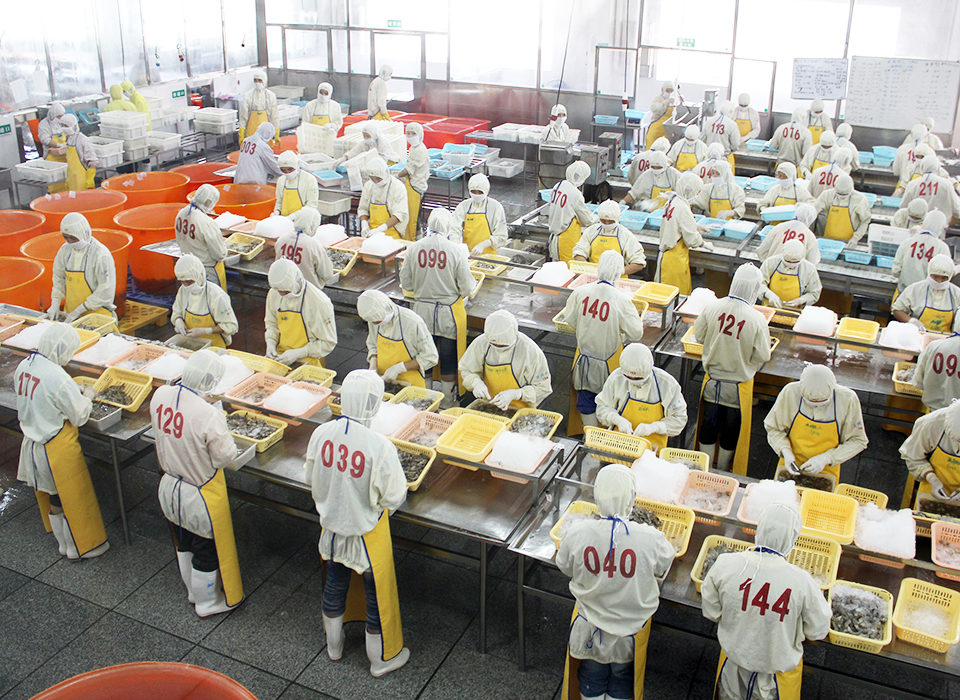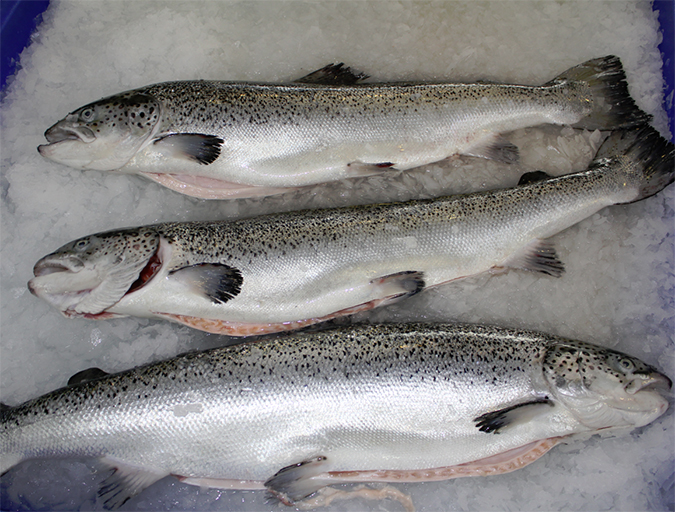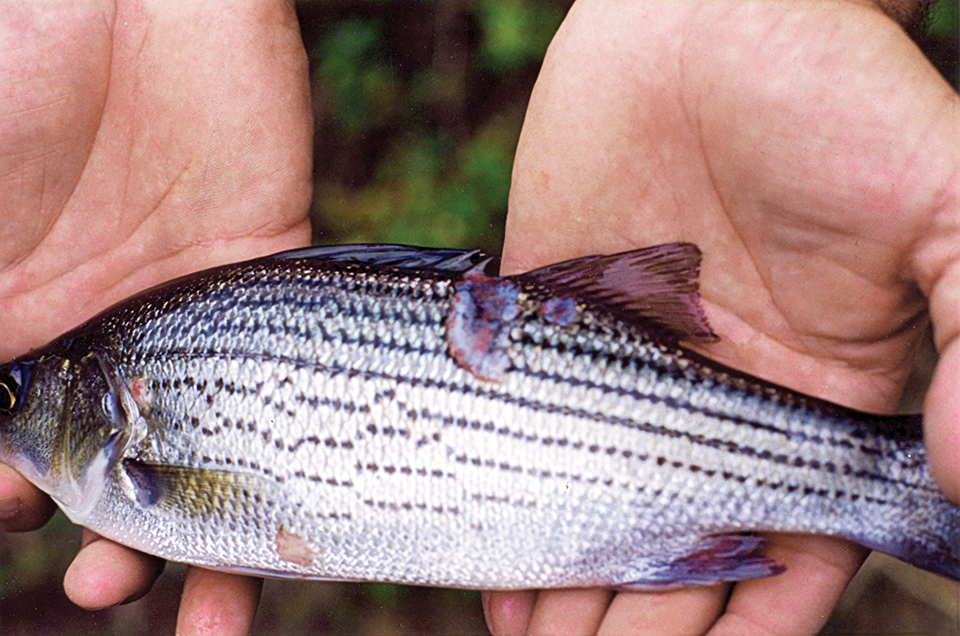Understanding interactions with antibiotic-resistant bacteria in a processing environment

The development and spread of antimicrobial resistance genes into human pathogens as a consequence of exposure to antibiotics in aquaculture is widely documented. For example, multi-resistance plasmids have been shown to be transferable to Escherichia coli from Aeromonas salmonicida, Aeromonas hydrophila, Edwardsiella tarda, Citrobacter freundii, Photobacterium damselae subsp. Piscicida, Vibrio anguillarum and Vibrio salmonicida.
Numerous reports directly implicate foodborne antibacterial-resistant pathogenic bacteria in human disease. However, only a limited number of published reports confirm the transmission of the resistant strains from primary production such as aquaculture into foods and subsequently to the human population.
It is very difficult to determine the amount of antibiotic resistance that passes through the food chain, and the role of food transfer of resistance genes has not been fully explored to date. Problems arise due to the delay between food exposure and infection. It is a difficult task to link human infections to resistant bacteria acquired from foods proceeding from aquacultured animals treated with selecting antibiotics.
The use of antibiotics in humans disturbs the intestinal microflora and decreases the colonization dose considerably. Individuals who take an antimicrobial agent are at increased risk of becoming infected with their own intestinal pathogens resistant to that agent. It has been estimated that in the United States, resistance to antimicrobial agents annually results in an additional 29,379 Salmonella infections, leading to 342 hospitalizations and 12 deaths; and an additional 17,668 Campylobacter jejuni infections, leading to 95 hospitalizations.
Antibacterial resistance in food processing
Food processing and preservation procedures are applied to extend shelf life, maintain quality and increase food safety. The processing operations, however, result in different effects on the bacterial flora.
Some bacteria present in farmed food products can survive after the application of a food processing or preservation process without their growth being inhibited. For others, growth is inhibited, resulting in stressed or sub-lethally damaged bacterial cells. Of course, food processing and/or preservation processes can kill or inactivate bacteria. Those dead bacterial cells can stay intact or be lysed due to cell wall damage. As a consequence, the bacterial DNA, including the potential antimicrobial-resistant genes, is liberated in the environment.
Aquaculture products such as salmon, tuna and yellowtail, which can be ingested without processing or preservation, can contain live, non-stressed bacterial cells at the time of ingestion. Such products may present a high risk for the transfer of antibacterial resistance, since any possibility present antibacterial-resistant bacteria are not killed or inactivated.
The transfer of antibacterial resistance genes from live bacteria to other bacteria in food or in the intestines after ingestion by humans can occur by means of conjugation. There is an increasing demand for raw and minimally processed food. These markets expand because they combine optimal taste with a maximum preservation of nutritional compounds.
Stress
Stress factors such as cold, heat and freeze injury, among others, can trigger several mechanisms in bacterial cells – stress adaption, cellular repair, application of response mechanisms and enhanced virulence. But besides these mechanisms, several studies demonstrated that stress can also impact the phenotype antimicrobial resistance of the microorganisms.
It has been shown that sublethal food preservation stresses such as heat, acid and salt stress can significantly alter antimicrobial resistance in food-related pathogens such as Escherichia coli, Salmonella typhimurium and Staphylococcus aureus. On one hand, sublethal high temperature decreased antimicrobial resistance, while increased salt or reduced pH conditions increased the phenotypical antimicrobial resistance. S. aureus subjected to salt stress showed increased antimicrobial resistance after being exposed to sublethal salt concentrations.
Biofilms
Microorganisms can grow and survive as biofilms on the majority of food-processing equipment. Biofilms can be defined as a microbial-derived sessile community characterized by cells that are irreversibly attached to a substratum or interface to each other, which are embedded in a matrix of extracellular polymeric substances they have produced, and which exhibit an altered phenotype with respect to growth rate and transcription.
Both monospecies and multispecies biofilms occur in food-processing establishments, where they can result in food spoilage and production of out-of-specification products. Biofilms can also present a health hazard if human pathogenic bacteria are present. An important health issue related to the occurrence of biofilms in food processing is their inherent higher antimicrobial resistance when compared to free cells. In addition to the inherent resistance, the biofilm state confers an ideal state for resistance transfer.
Bacterial resistance
Published studies provide different perspectives on the emergence of bacterial resistance due to disinfectants. A recent study observed that the use of certain types of disinfectants can increase bacterial resistance to various disinfectants and antibiotics. Oxidizing compounds notably decreased susceptibility to ciprofloxacin and various disinfectants. However, other studies have shown that the use of a disinfectant can increase resistance to various disinfectants but not to antibiotics.
Biocides
In a recent report, the European Union’s Scientific Committee on Emerging and Newly Identified Health Risks classified biocides according to their intrinsic potential for generating resistance/tolerance. Some biocides, because of the nature of their interactions with bacteria, are more prone to induce resistance/tolerance. This group of high-risk biocides contains the quaternary ammonium compounds, surface active agents, phenolics and metallic salts.
Highly reactive biocides (e.g., oxidizing and alkylating agents) present a low risk of emergence of bacterial resistance. Resistance to these biocides results mainly from their inappropriate use. Lastly, several other biocides (isothiazolones, anilides, diamidines, inorganic acids and their esters or alcohols) are classified as medium risk in terms of emergence of bacterial resistance.
(Editor’s Note: This article was originally published in the January/February 2015 print edition of the Global Aquaculture Advocate.)
Now that you've reached the end of the article ...
… please consider supporting GSA’s mission to advance responsible seafood practices through education, advocacy and third-party assurances. The Advocate aims to document the evolution of responsible seafood practices and share the expansive knowledge of our vast network of contributors.
By becoming a Global Seafood Alliance member, you’re ensuring that all of the pre-competitive work we do through member benefits, resources and events can continue. Individual membership costs just $50 a year.
Not a GSA member? Join us.
Authors
-

George J. Flick, Jr., Ph.D.
University Distinguished Professor
Food Science and Technology Department
Center for Applied Health Sciences
Duck Pond Drive
Virginia Tech (0418)
Blacksburg, Virginia 24061 USA -

David D. Kuhn, Ph.D.
Assistant Professor
Food Science and Technology Department
Center for Applied Health Sciences
Duck Pond Drive
Virginia Tech (0418)
Blacksburg, Virginia 24061 USA
Tagged With
Related Posts

Health & Welfare
A holistic management approach to EMS
Early Mortality Syndrome has devastated farmed shrimp in Asia and Latin America. With better understanding of the pathogen and the development and improvement of novel strategies, shrimp farmers are now able to better manage the disease.

Health & Welfare
Aquaculture viruses: An Atlantic salmon case study
Viruses often are the most potentially damaging pathogens in nature, affecting both wild stocks and farmed animals. Due to an Infectious Haematopoietic Necrosis (IHN) viral outbreak that occurred in Atlantic salmon in British Columbia, Canada some years ago, a vaccine for IHN was developed against this serious threat.

Health & Welfare
Biosecurity practices on fish farms need beefing up
Biosecurity measures and preventive strategies are essential in any biological production chain. Properly planned and implemented biosecurity programs will enhance animal health, production and economics.

Health & Welfare
Antibiotic-resistant bacteria, part 1
No antimicrobial agent has been developed specifically for aquaculture applications. However, some antibiotic products used to treat humans or land-based animals have been approved for use at aquaculture facilities.


